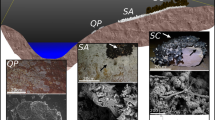Abstract.
A combined use of molecular ecological techniques and geochemical surveys revealed that thermophilic or hyperthermophilic microorganisms living in geothermal environments are likely to be implicated in the formation of biogenic siliceous deposits. Electron microscopic observations indicated that numerous microorganism-like fabrics were preserved in naturally occurring siliceous deposits such as siliceous sinter, geyserite, and silica scale, which suggests microbial contribution to silica precipitation. Molecular phylogenetic analyses suggested that extreme thermophilic bacteria within the genera Thermus and Hydrogenobacter are predominant components among the indigenous microbial community in siliceous deposits formed in pipes and equipment of Japanese geothermal power plants. These bacteria seem to actively contribute to the rapid formation of huge siliceous deposits. Additionally, in vitro examination suggested that Thermus cells induced the precipitation of supersaturated amorphous silica during the exponential growth phase, concomitant with the production of a specific cell envelope protein. Dissolved silica in geothermal hot water may be a significant component in the maintenance of position and survival of microorganisms in limited niches.
Similar content being viewed by others
Author information
Authors and Affiliations
Additional information
Electronic Publication
Rights and permissions
About this article
Cite this article
Inagaki, .F., Motomura, .Y. & Ogata, .S. Microbial silica deposition in geothermal hot waters. Appl Microbiol Biotechnol 60, 605–611 (2003). https://doi.org/10.1007/s00253-002-1100-y
Received:
Revised:
Accepted:
Issue Date:
DOI: https://doi.org/10.1007/s00253-002-1100-y




